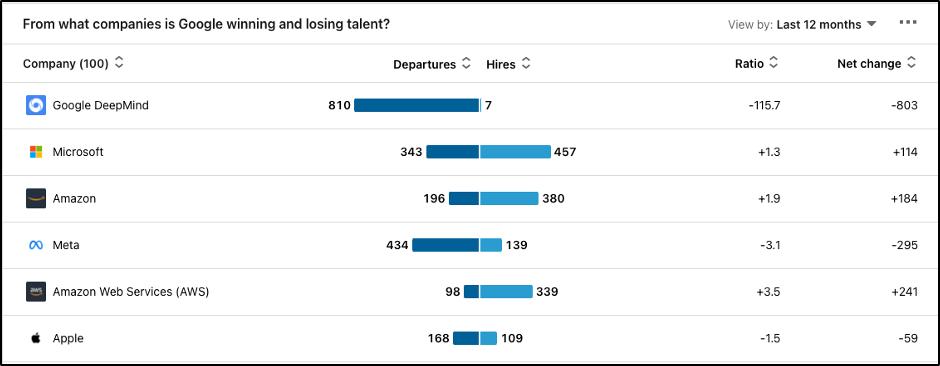Artificial Intelligence (AI) is transforming the way recruiters and talent acquisition professionals source and engage with candidates. From market mapping to automated candidate discovery, AI-powered tools can streamline processes, reduce bias, and enhance decision-making. However, while AI is a valuable asset, it should complement rather than replace human expertise.
Here’s how AI can be effectively integrated into your sourcing strategy:
1. Market Mapping & Targeting Companies
Identifying and mapping target companies is a critical first step in talent sourcing. AI can help by:
- Expanding target company lists: AI analyzes industry data and suggests additional companies where top talent may be found.
- Reducing bias: By evaluating company and industry trends objectively, AI minimizes human bias in selection.
- Tracking macro & leadership changes: AI can monitor C-suite shifts, mergers & acquisitions, and restructuring—alerting recruiters to potential sourcing opportunities.
- Automating alerts: AI-driven automation keeps track of stock price fluctuations, funding rounds, and company news that signal hiring / reduction (RIF) trends.
- Identifying strong sourcing geographies: AI can analyze economic conditions and workforce trends to pinpoint talent-rich locations.
By leveraging AI in market mapping, recruiters can stay ahead of shifts in talent demand and identify new sourcing opportunities.
My favorite AI tool to leverage for Market mapping is Claude (Anthropic). For example, I asked Claude: “What are the Top 10 Digital Payment Companies in San Francisco” and I immediately received the following list:
- Stripe – Global online payment processing platform
- Square/Block – Mobile and digital payment solutions
- PayPal – International digital payments and money transfers
- Brex – Corporate payment and expense management
- Affirm – Buy now, pay later digital payments
- Coinbase – Cryptocurrency payment platform
- Plaid – Financial technology connecting payment systems
- WePay (Chase) – Digital payment integration for platforms
- Marqeta – Modern card issuing and payment infrastructure
- SoFi – Digital banking and payment services
2. AI-Powered Sourcing
AI-driven sourcing tools enhance candidate discovery by:
- Automating candidate identification: Tools like HiredScore and SeekOut use AI to find candidates matching specific criteria.
- Finding similar profiles and companies: AI suggests alternative candidates based on skill, experience, and career trajectory. My favorite AI tools for providing strong comparisons are ChatGPT, Claude and DeepSeek.
- Refining Boolean searches: AI-powered search tools review and optimize Boolean strings to enhance search accuracy (Claude, DeepSeek, ChatGPT).
- Targeting underrepresented groups: AI can help identify and engage diverse talent by analyzing where underrepresented candidates are most active. See example search result below:
I asked Claude: “What tech companies in San Francisco have the largest diverse employee populations?”
- Salesforce: 47% women globally, 51% underrepresented groups (US) & Strong LGBTQ+ representation
- Google: 43% women globally, 48% underrepresented groups, Comprehensive DEI programs
- Apple: 45% women globally, 50% underrepresented groups, Industry-leading inclusion initiatives
- Meta: 41% women globally, 45% underrepresented groups, Structured diversity recruiting
- Uber: 42% women globally, 46% underrepresented groups, Active ERG programs
By utilizing AI-powered sourcing, recruiters can broaden their talent pipelines and improve candidate matching accuracy.
3. Improving LinkedIn & job posts: AI can analyze job descriptions and LinkedIn posts, optimizing them for higher visibility, inclusivity and better applicant quality.
My preferred tools for improving messaging are Grammarly and Textio. Together, these applications help refine draft messages by ensuring proper grammar, tone, and inclusivity. In short, AI can significantly enhance recruiting messages by making them more personalized, engaging, and data-driven—ultimately increasing response rates and improving the candidate experience.
4. Screening & Matching Candidates
Once candidates are sourced, AI can assist in screening and engagement through:
- Leveraging Chatbots for candidate interactions: AI-powered chatbots answer repetitive candidate questions, schedule interviews, and provide real-time engagement. Examples of these AI tools include:
- HireVue – (Video interviews, NLP, Behavior Analysis & Personality Assessment)
- Pymetrics – (Behavioral Analysis & science-based assessment)
- Paradox – (Olivia AI) – (Conversational software to automate TA tasks)
- AI – (Chatbot interviews – best for hourly / blue collar roles)
- Upwage – (Automated AI interviewing & assessment)
By using AI in screening and engagement, recruiters save valuable time and improve the candidate experience.
5. Benchmarking & Market Insights
AI can provide real-time insights into hiring trends and competitor strategies, helping recruiters:
- Benchmark talent sources: AI analyzes where top competitors find their talent, revealing new sourcing channels. For instance, I asked Claude “What companies does Google hire the bulk of their technical talent from?
Google’s main technical talent sources (Instant reply from Claude):
Top Companies:
- Microsoft
- Amazon
- Meta/Facebook
- Apple
- Oracle
- IBM
- Intel
- Startup acquisitions
- Top consulting firms (McKinsey, BCG)

Where does OpenAI hire most of its talent from (Instant reply from Claude)
Top Companies:
- Google (especially DeepMind/Brain)
- Meta AI Research
- Microsoft Research
- Apple AI/ML teams
I cross-referenced the feedback from Claude with the images above and below from LinkedIn Talent Insights to validate Claude’s feedback and confirm the accuracy of both lists.

- Track market trends: AI can monitor macro-trends, skill demands, and hiring patterns, ensuring recruiters stay informed about industry shifts.
- Shifts in stock price can be monitored through automated notifications from Robinhood, Yahoo and Bloomberg.
- Macro shifts and economic patterns can be monitored through tailored event notifications (i.e.: WSJ, MarketWatch, Tradingview)
By leveraging AI-driven market intelligence, recruiters can make data-backed hiring decisions and stay ahead of competitors.
Final Thoughts: AI is a Tool, Not a Replacement
AI-driven platforms like ChatGPT, Claude, and DeepSeek are powerful tools that can enhance sourcing efficiency, automate tasks, and provide strategic insights. However, human intuition, creativity, and relationship-building remain irreplaceable in recruitment. The most effective approach is to integrate AI strategically while maintaining a human touch throughout the hiring process.
By doing so, recruiters can work smarter, not harder, to achieve better hiring outcomes without becoming overly dependent on AI.
Leverage AI to improve your sourcing strategy, do not be reliant on it.
